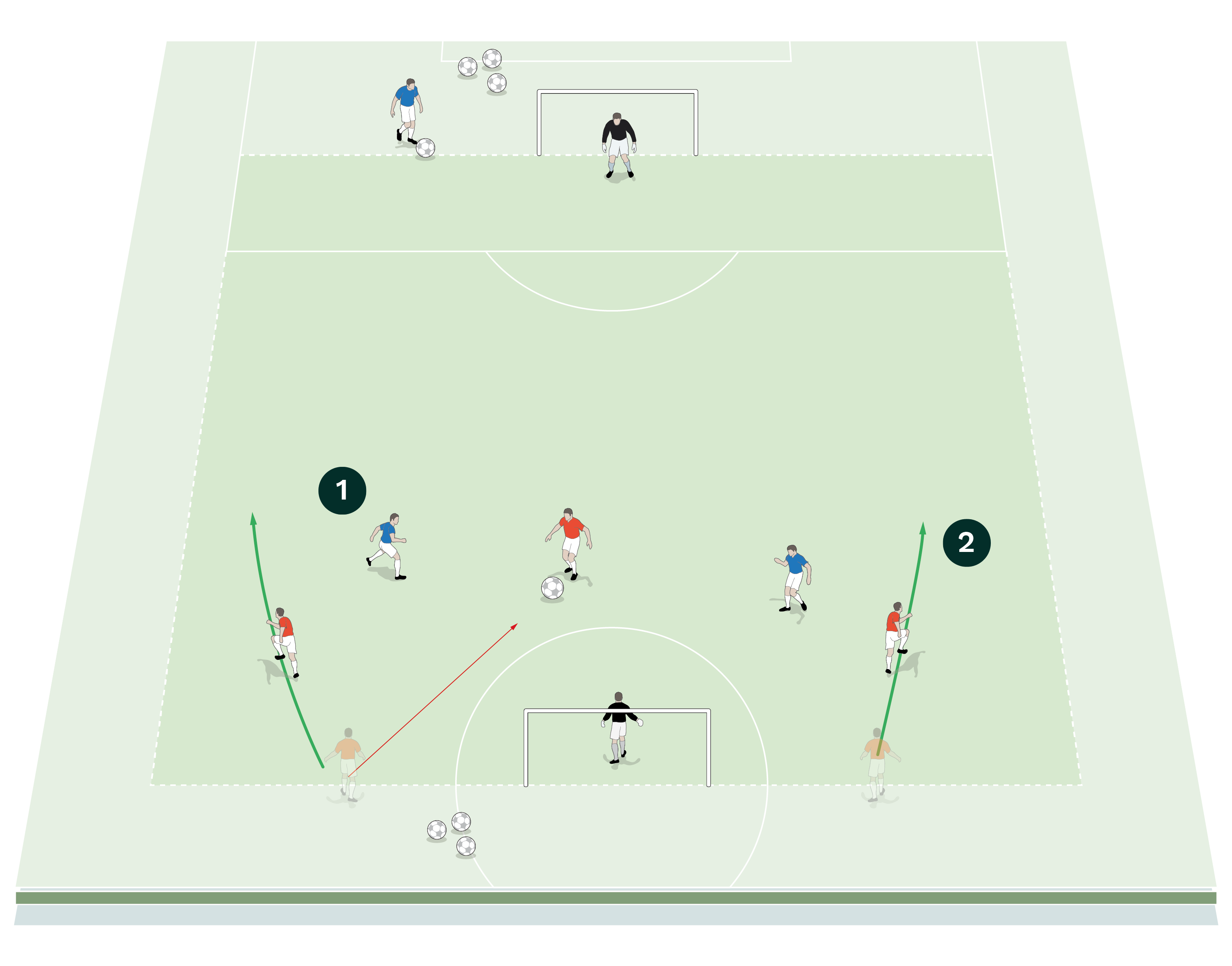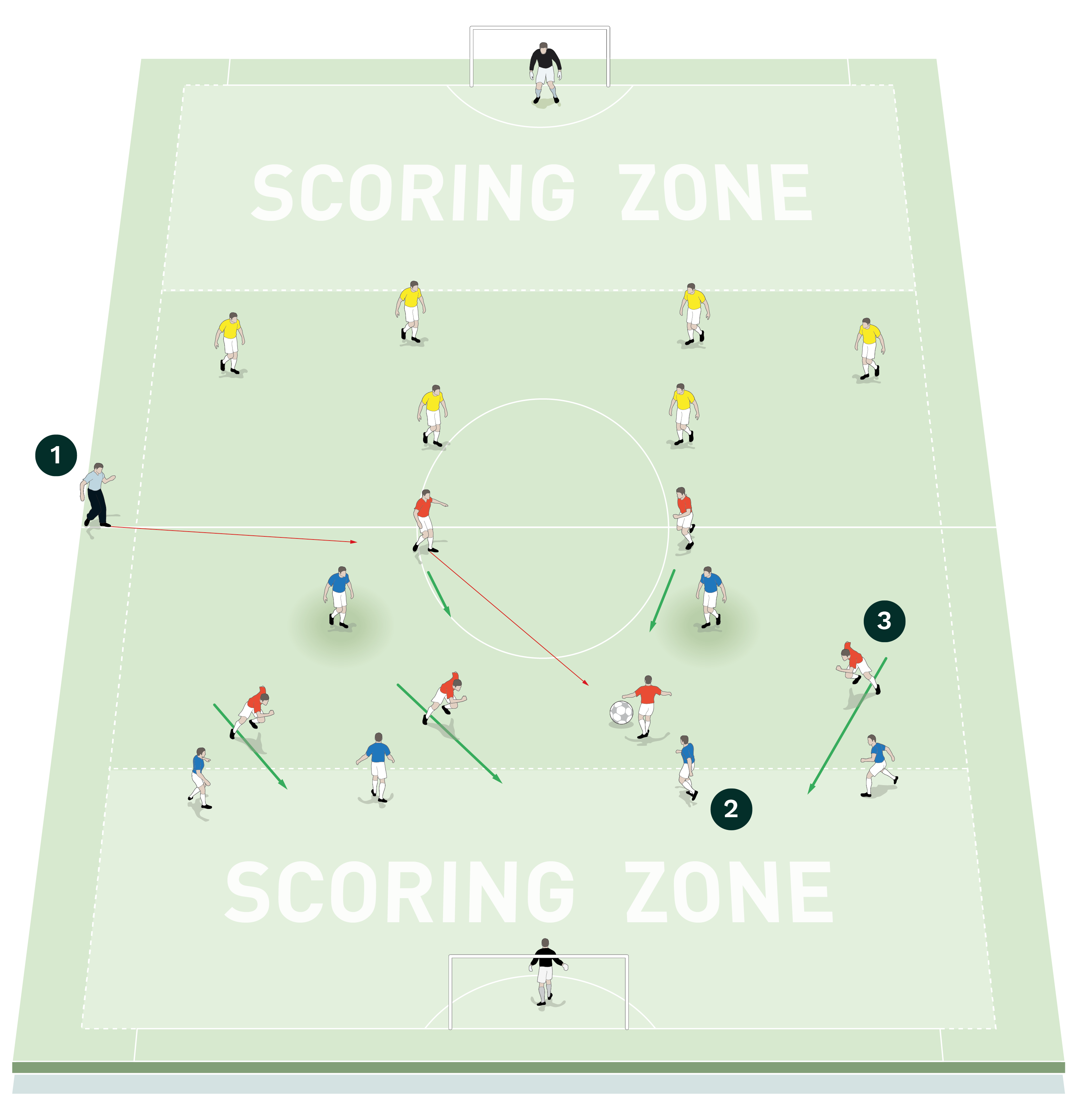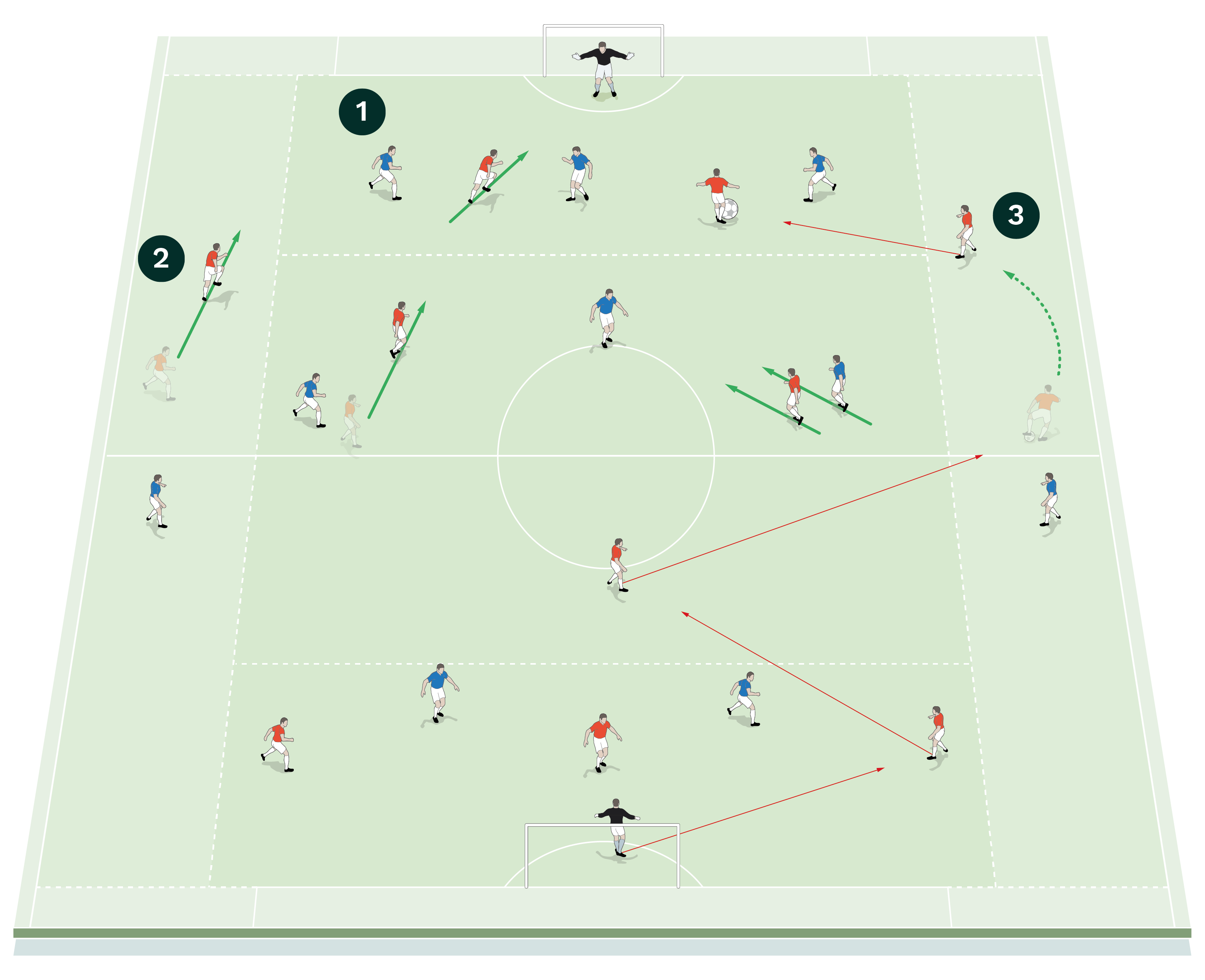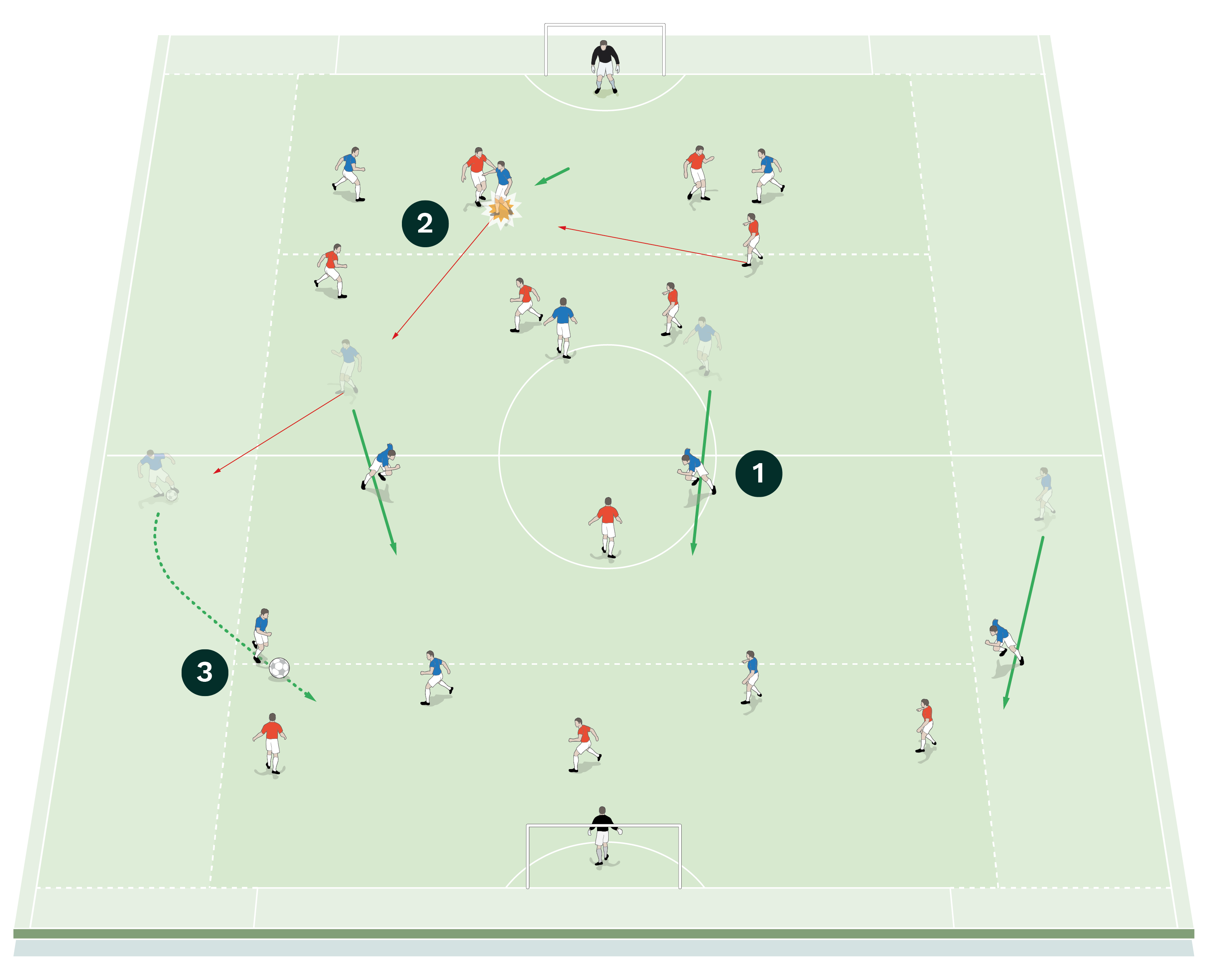You are viewing 1 of your 1 free articles
Improving counter-attacks
| Area | Up to two-thirds of a pitch |
| Equipment | Balls, bibs, cones, 2 full size goal |
| No. of Players | Up to 20 players + 2 goalkeepers |
| Session Time | Counter-attacking waves: 20 mins Counter-attacking game: 20 mins Counter flow game: 25 mins |
This counter-attacking session is built around our own counter-attacking principles. It progresses from a simple wave practice and eventually leads into a small-sided game, where everything that we get the players to do revolves around our counter-attacking principles. This means winning the ball back quickly and always making the first or second pass forwards, without slowing down the play. The speed and timing of supporting runs is also important, as is the type of support and the finish. We like to try to expose defences that have been outnumbered by our counter- attacking overload.
As a session, it engages players because they think it’s pretty realistic and because it culminates in the short, sharp, attacking style of the small- sided game, where there are always opportunities to attack and to finish.
There’s also a defending side to it because, in the face of the counter- attacks, the defence is always overloaded, so the defenders have to work out how they should solve problems at the back.
It fits into our own playing style and principles because, although we’re a front-footed, forward-thinking side, we can’t always be front-footed. Sometimes, against the strong teams in the Championship, we have to defend and then from a really strong position we counter-attack quickly and look to hurt the opposition at a time when they have been trying to hurt us.
We have strong principles around counter-attacking, which aren’t just sporadic. These principles are drilled into the players week-in and week-out. We think that counter-attacking is a process, rather than just a something to react against and prevent. We prefer to be front-footed in our play but we always know that we have the option to counter-attack should we need to.
COUNTER-ATTACKING WAVES
For this directional wave game, we set up a playing area between the penalty spot and the halfway line and cone it off to the width of the penalty area. We position a goal and a goalkeeper at each end.
We’re using six outfield players split into two teams of three, plus two goalkeepers. The players wait to start either side of their own goal, with the three blues starting at one end and the three reds starting at the other end.
The reds start in possession and play begins on the coach’s call, with one red attacker dribbling the ball out into the pitch with the aim of finishing past the goalkeeper, as shown [1a].
Once the red attacker has had an attempt on goal, two blue players attack the opposite goal in a 2v1 situation against the original red attacker, who now attempts to recover and defend against the counter- attack, as shown [1b].
[1a]

2. One red attacker dribbles into the pitch unopposed with the aim of finishing past the blue goalkeeper
3. The three blue outfield players remain static on either side of their goal for the first attack
[1b]

2. Two blue players then attack the opposite goal with a new ball against the original red attacker in a 2v1 situation. The blues try to score a counter-attacking goal
[1c]

2. Three reds surge forward with a new ball, attacking the two blues with a 3v2 overload
[1d]

Once the blue attack is completed and the ball is dead, the two blue players stay on the pitch and either press high or recover to defend against all three red attackers who surge forward from their end, combining with the ball. The reds try and capitalise on their 3v2 overload and try to score, as shown [1c].
Once the 3v2 attack has been completed and the ball is dead, the final blue player brings a new ball out into the pitch to join his team-mates in attacking the three reds, creating a 3v3 situation to finish the round of attacks, as shown [1d].
The process then begins again, with the next round of attacks starting with the blue team attacking in a 1v0 situation against just the red goalkeeper.
We play this for 20 minutes, placing the coaching emphasis on quick breaks, forward momentum and finishing the attack. We also work on encouraging supporting runs and on the timing of passes and the timing of runs to finish with a shot on goal.
“Sometimes, against strong teams, we have to defend and then from a really strong position we counter-attack and look to hurt the opposition when they are trying to hurt us”
COUNTER-ATTACKING GAME
We set up a playing area between the two penalty boxes and cone it off to a width two yards wider than the penalty area on each side. We mark out scoring zones and position a goal and a goalkeeper at each end, as shown. We’re using 18 outfield players split into three teams of six. The red team starts in the centre of the pitch as the attackers and the blue and the yellow teams start at each end and are made up of four defenders and two midfielders.
The coach starts play by serving a ball into the red team in the central area, who attack the four blue defenders (the two blue midfield players are not involved in defending the attack). The reds aim to enter the scoring zone in the final third of the pitch, as shown [2a]. We want to see the red team producing neat attacking combination play to create goal-scoring opportunities, as shown [2b].
[2a]

2. Only the four blue defenders can attempt to stop the attack. The two blue midfielders remain static
3. The reds aim to enter the scoring zone in the final third of the pitch and create a scoring chance
[2b]

2. The four blue defenders must try scoring and launch a counter-attack if they win possession
3. The two blue midfielders remain inactive until the blues launch a counter-attack
[2c]

2. The six blues then launch a counter-attack on the yellow team at the opposite end of the pitch
3. The blue midfielders are now active and should make well- timed attacking runs, supported by the blue defenders
[2d]

2. Two yellow midfielders remain inactive while the blues counter-attack
3. The four yellow defenders try to stop the blue counter-attack
4. The red team who made the first attack now push up ready to defend against the next counter-attack when it comes in their direction
Once the attack has been completed, the coach plays a new ball into the blue team who launch an attack on the yellow team at the opposite end of the pitch, as shown [2c]. As the blue team counter-attack, they try to create a new 6v4 situation as quickly as possible, with the two yellow midfielders remaining static and not involved in defending the attack, as shown [2d]. The reds now take over as the new defending team at the other end of the pitch and wait for the counter-attack to come in their direction.
The game continues to flow in this manner. We play for 20 minutes, placing the coaching emphasis on quick breaks, forward momentum and finishing the attack. We work on encouraging supporting runs and look for players to use the correct timing of pass. We also want to see well-timed runs to finish the counter-attack with a shot on goal.
11v11 COUNTER-FLOW GAME
We set up a playing area between the two penalty boxes, using the full width of the pitch and we position a goal and a goalkeeper at each end. We also mark out end zones and wide zones, as shown.
We’re using 20 outfield players and two goalkeepers split into two full teams of 11, set up as shown with teams playing with three at the back in the end zones and wing backs pushing high up in the wide zones in the attacking half of the pitch.
The object of the game is to attack quickly using wing backs. We want to see a constant flow of counter-attacks in both directions, with teams encouraged to attack in numbers without worrying about the spaces left behind them. This will allow the other team to counter with a numerical advantage higher up the pitch on transition.
We want players following our counter-attacking principles and, after winning the ball, we want to see the first or second pass always being played forwards.
We play three games using this set-up, with different restrictions and rules applied. For the first game, we want players sticking rigidly to their starting zones, with no players allowed to come out of their zones, as shown [3a], not even the attacking wing backs.
[3a]

2. The team in possession can use both of their wing backs to attack and help to create goal-scoring opportunities
3. Here the right wing back quickly attacks high up the pitch but has to remain in the wide zone when passing the ball into the end zone
“The object of the game is to attack quickly using wing backs. We want to see a constant flow of counter-attacks in both directions”
[3b]

[3c]

2. In transition, the team that wins possession should aim to produce a direct counter-attack as quickly as possible
3. Here the blues create a 6v4 counter-attacking situation with two central midfield players and the two wing backs supporting the two centre forwards
For the second game, we now allow the wing backs to leave their wide zones and come inside the pitch to attack. We encourage as many players as possible to join the attack with them, as this will leave gaps behind for opposition attackers to exploit, as shown [3b]. This creates even more counter-attacks for our players to execute and rehearse defending against on transition.
For the third game, all players can now move freely between zones and we want to see players responding quickly to transitions of possession. After winning the ball the counter-attacking teams should aim to create a 6v4 attacking situation with two central midfield players and the two wing backs supporting the two centre forwards, as shown [3c].
We play this activity for 25 minutes.
Related Files
Editor's Picks
Deep runs in the final third
Using the goalkeeper in build-up play
Pressing principles
Intensive boxes drill with goals
Penetrating the final third
Creating and finishing
My philosophy
Pressing initiation
Compact team movement
Coaches' Testimonials

Alan Pardew

Arsène Wenger

Brendan Rodgers

Carlos Carvalhal

José Mourinho

Jürgen Klopp

Pep Guardiola

Roy Hodgson

Sir Alex Ferguson

Steven Gerrard
Coaches' Testimonials

Gerald Kearney, Downtown Las Vegas Soccer Club

Paul Butler, Florida, USA

Rick Shields, Springboro, USA

Tony Green, Pierrefonds Titans, Quebec, Canada
Join the world's leading coaches and managers and discover for yourself one of the best kept secrets in coaching. No other training tool on the planet is written or read by the calibre of names you’ll find in Elite Soccer.
In a recent survey 92% of subscribers said Elite Soccer makes them more confident, 89% said it makes them a more effective coach and 91% said it makes them more inspired.
Get Monthly Inspiration
All the latest techniques and approaches
Since 2010 Elite Soccer has given subscribers exclusive insight into the training ground practices of the world’s best coaches. Published in partnership with the League Managers Association we have unparalleled access to the leading lights in the English leagues, as well as a host of international managers.
Elite Soccer exclusively features sessions written by the coaches themselves. There are no observed sessions and no sessions “in the style of”, just first-hand advice delivered direct to you from the coach.









